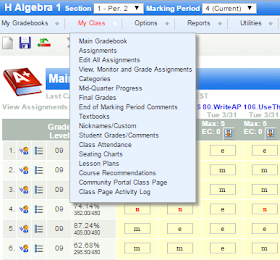In this post I'll describe how I set up my gradebook. I used
a blend between standards based grading and traditional grading. If you were to use a 100% SBG approach, your
gradebook set-up would be a little easier because you would only assess student
progress towards mastery of standards. Therefore, you would have fewer categories (if any). I
use an 80%-20% split between SBG and traditional grading. Although I love SBG, I feel like I could not
measure complex tasks via SBG.
Therefore, I wanted to have a way to incorporate projects and group work
into students' grades. I also wanted to
track traditional things like assignment completion, participation, and
preparedness. Each of these things ends
up being a very small portion of the grade, but it is still helpful to have
access to this data when looking back at student progress to identify areas for
improvement.
My school uses Sapphire but I also used PowerSchool , Sasi,
and LearnBoost and I could have done the
same thing with those programs. I
started by choosing the categories that I wanted to use in the gradebook (each
individual 'assignment' would need a caetgory to determine its weight in the
grade calculation). Here is what I use:
u 80%
- Objectives – This portion of your grade communicates the level of mastery
that has been demonstrated on the important course topics.
u 0%
- Evidence – This portion of your grade communicates your progress towards
mastery for course topics that are in progress and have not yet been fully
assessed. This is a temporary
category. Once a topic is completed, it
will become an objective (see above).
u 5%
- Independent work – This portion of your grade is graded for accuracy, but in
a traditional way (point earned ÷ points possible · 100). These assignments are completed individually.
u 5%
- Collaborative work - This portion of your grade is graded for accuracy, but in
a traditional way . These assignments
are completed in groups of 2-4 students.
u 5%
Non-routine problems and projects - This portion of your grade is graded for
accuracy, but in a traditional way.
These assignments might be completed individually or in groups. These assignments measure the mastery of complex skills in novel
situations.
u 5%
- Warm-ups, homework, participation, preparedness, progress reports, and exit
tickets - This portion of your grade is graded for completion, in a traditional
way. These assignments are completed
individually.
To set up categories in Sapphire you first need to open any class then choose 'categories' from the "My Class" drop down menu.
One at a time, enter each category. This is the same as you would do for a traditional grading system except that you can see that I instructed Sapphire to use the 'Objectives' category as 80% of the overall grade.
Next, for the SBG portion of the grade, I chose my levels of
mastery. In an earlier post, I described
these levels of mastery in greater detail.
I came up with the following shorter descriptions that I used for grade mapping. These descriptions show up at the bottom of
my students' progress reports as a quick way to help students and parents to
interpret the meaning of grades.
u E=
Exceeds Expectations (translates to a grade of 100%): Demonstrates an in-depth
understanding of the material by completing advanced applications consistently
and independently
u M
= Meets Expectations (translates to a grade of 80%): Demonstrates a adequate
understanding of the material by completing grade-level tasks consistently
and independently
u N
= Nearly Meets Expectations (translates to a grade of 60%): Demonstrates a partial
understanding of the fundamental material, by completing basic tasks,
but is still working to master the complex material on a consistent
basis
u Y
= Does Not Yet Meet Expectations (translates to a grade of 40%): Demonstrates minimal
understanding of the fundamental material, by completing basic tasks with inconsistent
success
u U
= Unrated (translates to a grade of 0%): Demonstrates no understanding
of the fundamental material, even at the most basic level
Enter each level of mastery in the description section and include the character (letter) you will be typing into the gradebook as well as the numerical value you want it to be mapped to.
Here is one final comment.
I had a teacher ask me about using state standards rather than my own objectives. I wrote about my rational for using my own objectives once before, but this teacher wanted to use the PA English standards. What she decided to do was to basically keep
a traditional grading system, but instead of having traditional categories such
as homework, classwork, and tests, she had categories based on the state
anchors such as informative, revision, conventions, argumentative, fiction,
analyzing and interpreting. She then
recorded individual assignments in the gradebook but only grading them for one category
at a time. For example, maybe her
students would be asked to write a paper about racism in Othello. Then she would grade the essays only on information
and record that grade in the informative category. Maybe she would re-grade the essay for grammar
and mechanics and then record a second grade under the conventions
category. I think this would certainly
be another way to use SBG. It may be
more realistic in a school that wants to move to a standards based report card
and transcript as it would be more difficult to report on 100+ objectives per
course.




No comments:
Post a Comment